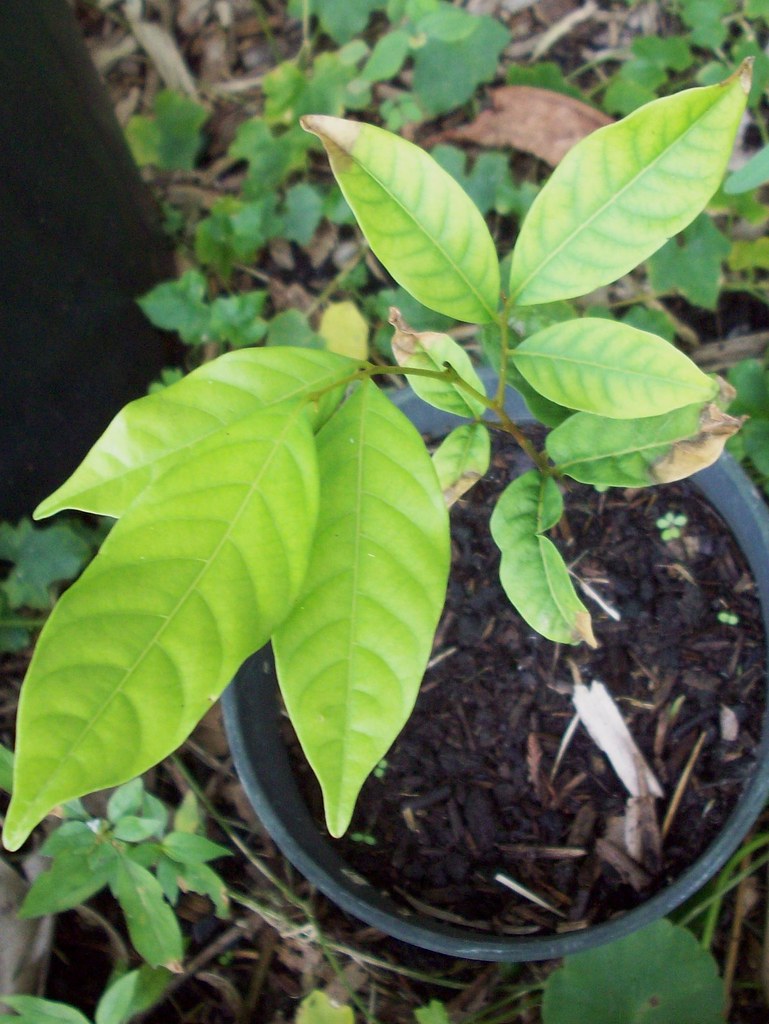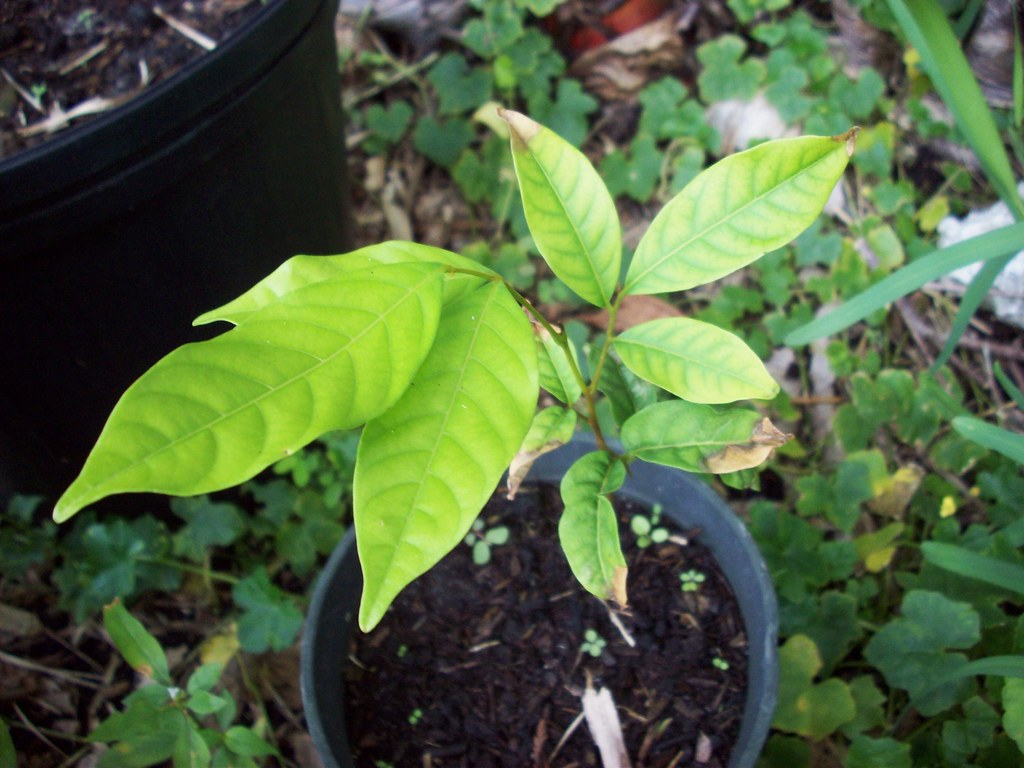

Family: Sapindaceae •
Genus: Nephelium •
Species: lappaceum (L.) •
Country of Origin: Malay Archipelago •
Common Names: Rambutan, Mamón Chino •
I purchased some fruit from Whole Foods™ market nine to be exact. After chowing down on the fruit, which were delicious! I cleaned up the seeds and planted them. Only the one seen here sprouted. It seems to be doing well though. I'll posts updates from time to time. 'Fruits of Warm Climates' by J. Morton, says that this species is dioecious. Hopefully the tree will turn out a hermaphrodite so it will produce fruit. If not I'll be looking for some budwood to do a graft. Anyone growing Rambutan?
The rambutan tree reaches 50 to 80 ft (15-25 m) in height, has a straight trunk to 2 ft (60 cm) wide, and a dense, usually spreading crown. The evergreen leaves are alternate, pinnately compound, 2 3/4 to 12 in (7-30 cm) long, with reddish rachis, hairy when young, and 1 to 4 pairs of leaflets, subopposite or alternate, elliptic to oblong-elliptic, or rather obovate, sometimes oblique at the base; slightly leathery; yellowish-green to dark-green and somewhat dull on the upper surface, yellowish or bluish-green beneath; 2 to 8 in (5-20 cm) long, 1 to 4 1/3 in (2.5-11 cm) wide, the 6 to 15 pairs of principal veins prominent on the underside. The small, petalless flowers, of three kinds: males, hermaphrodite functioning as males, and hermaphrodite functioning as females, are borne in axillary or pseudo-terminal, much branched, hairy panicles. These are the fruits the seeds came from.
These are the fruits the seeds came from.
The fruit is ovoid, or ellipsoid, pinkish-red, bright-or deep-red, orange-red, maroon or dark-purple, yellowish-red, or all yellow or orange-yellow; 1 1/3 to 3 1/8 in (3.4-8 cm) long. Its thin, leathery rind is covered with tubercles from each of which extends a soft, fleshy, red, pinkish, or yellow spine 1/5 to 3/4 in (0.5-2 cm) long, the tips deciduous in some types. The somewhat hairlike covering is responsible for the common name of the fruit, which is based on the Malay word "rambut", meaning "hair". Within is the white or rose-tinted, translucent, juicy, acid, subacid or sweet flesh, 1/6 to 1/3 in (0.4-0.8 cm) thick, adhering more or less to the ovoid or oblong, somewhat flattened seed, which is 1 to 1 1/3 in (2.5-3.4 cm) long and 2/5 to 3/5 in (1-1.5 cm) wide. There may be 1 or 2 small undeveloped fruits nestled close to the stem of a mature fruit.
http://www.hort.purdue.edu/newcrop/morton/rambutan.html
Nephelium lappaceum Rambutan Seedling by Eric Bronson is licensed under a Creative Commons Attribution-Noncommercial-No Derivative Works 3.0 United States License.
Based on a work at www.flickr.com
Tuesday, October 21, 2008
Nephelium lappaceum Rambutan Seedling
Posted by Eric Bronson at 10:41 AM
Labels: sapindaceae, tropical fruits
Subscribe to:
Post Comments (Atom)

6 comments:
I'm impressed, never seen rambutan outside of SEAsia.
From what I've seen, rambutan are quite large trees. I hope you have enough space!
This so much looks like my little bay plants, I'm wondering if it too has aromatic leaves?
Esther
@ Julian http://www.blogger.com/profile/09995954836400807202
I grow rare tropical fruits for a hobby!!! I have lots of unusual things as seen here http://ilikerareplants.blogspot.com/search/label/tropical%20fruits
@ Esther http://www.blogger.com/profile/15353320286277755358
I actually had to check, but alas no. This tropical fruit is related to lychee and longan. It is hard to describe it. It's a hairy alien looking fruit seen here http://www.flickr.com/search/groups/?q=rambutan&w=551822%40N23&m=pool I guess maybe grape-like would be close to what it tastes like. Hope that helps.
Eric
WOW! How old is it?! No wonder trees take ten years to fruit up here, if they do fruit. I better start making sure I like the foliage before I buy anything more!
@ lzyjo - It's not even a year old yet! All the experts say I'll never grow Rambutan here because it is ultra-tropical (meaning it can't bear temperatures below 40f degrees) but these seeds came from Mexico so I'm hopeful to have success. I can't remember it getting below 40f in a long time anyway! (global warming?)
Rambutan is increasingly common in Latin America. Many people don't realize it, but it has an edible seed. I often eat the entire fruit, seed and all, raw. Seedling trees can get bi (sometimes bearing in as little as three years).
I'm not positive, but from your photos it looks like the seedling may have a micronutrient deficiency, perhaps magnesium. Epsom salts are a great natural source of magnesium, in addition to other micronutrients. Try foliar feeding with Epsom salts dissolved in water with a drop of dish soap. Might help turn the leaves a deeper green.
Post a Comment